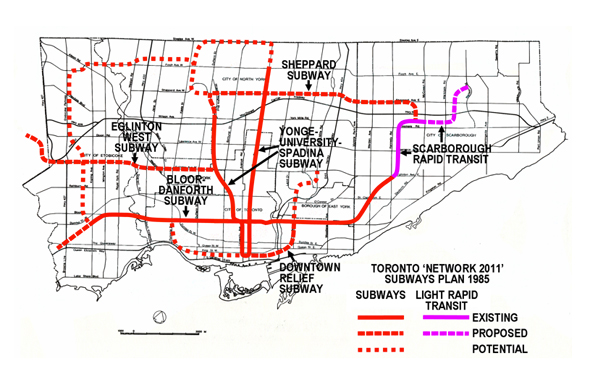Yes, but that 11k peak projection is only for the initial 5.5km of a DRL. IMO 11,000 peak for a short 5.5km line is actually pretty decent. Not to mention it's double the Crosstown’s projected peak, but for half its length. If we want to compare apples to apples, I think it’d be better to compare the entire DRL from Don Mills to Dundas West (i.e DRTES Option 3). 1986 projections for an almost identical route were 11,7000 by 2011
Only 11.7k pphpd by 2011? 11,700 pphpd is horribly low for an 18 km route. That's worse performance than the even Scarborough subway extension's highest usage projections (11,000 pphpd, but more concentrated; 7km vs 18km). I wouldn't be surprised if usage on some parts of that route, particularly the Don Mills segment, drop to as low as the Sheppard Subway.
Anyways, looking at the history of the Relief Line and TTC usage, I really don't see a point where it made any sense to build the Relief Line.
In the 1980s, Yonge Line capacity wasn't an issue. Bloor-Yonge station was going to be upgraded, so it could handle transfers adequately. As you pointed out, in 2011 the line was expected to move 11k pphpd, so obviously it would be a lot lower than this in the 80s/90s period,
In the 90s and early 2000s, the TTC was going through a massive ridership slump. Obviously Yonge and B-Y station capacity would have been a non issue back then. The provincial subsidy for the TTC was eliminated. Throughout the 90s and early 2000s, the Relief Line would have been underused, and more critically, the TTC probably couldn't afford to operate the line without provincial subsidy, as it likely would not have been profitable. As Silence&Motion pointed out, the strategy back then was to get more people onto existing subways, rather than building new, unnecessary lines (a logical strategy, in my opinion).
In the mid 2000s, Yonge capacity is becoming an issue. This is why the TTC is moving to install ATO on Line 1, and to replace all of the Hawker series transits with TRs early. It was anticipated that ATO and TRs would be able to handle demand.
Finally, in 2007 the Yonge North extension is proposed. With it moving 26,000 persons southbound though Finch at peak AM hour, ATO and Toronto Rockets will not be able handle the demand, as we had previously expected. City of Toronto moves forward with the Relief Line.
Nowhere in this timeline do I see a point where building the DRL earlier made any sense. The only thing I may have done differently is perhaps expedite the Relief Line study process in 2007, so that the line would open in the first half of the 2020s, rather than the second half.










